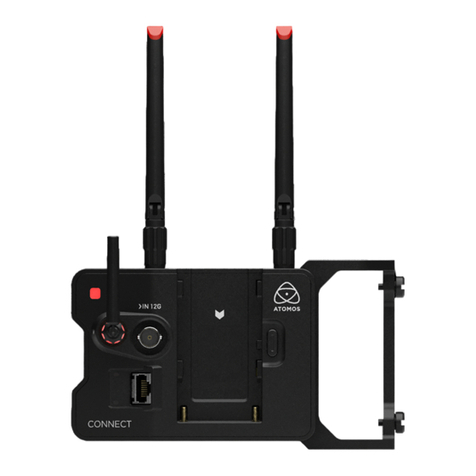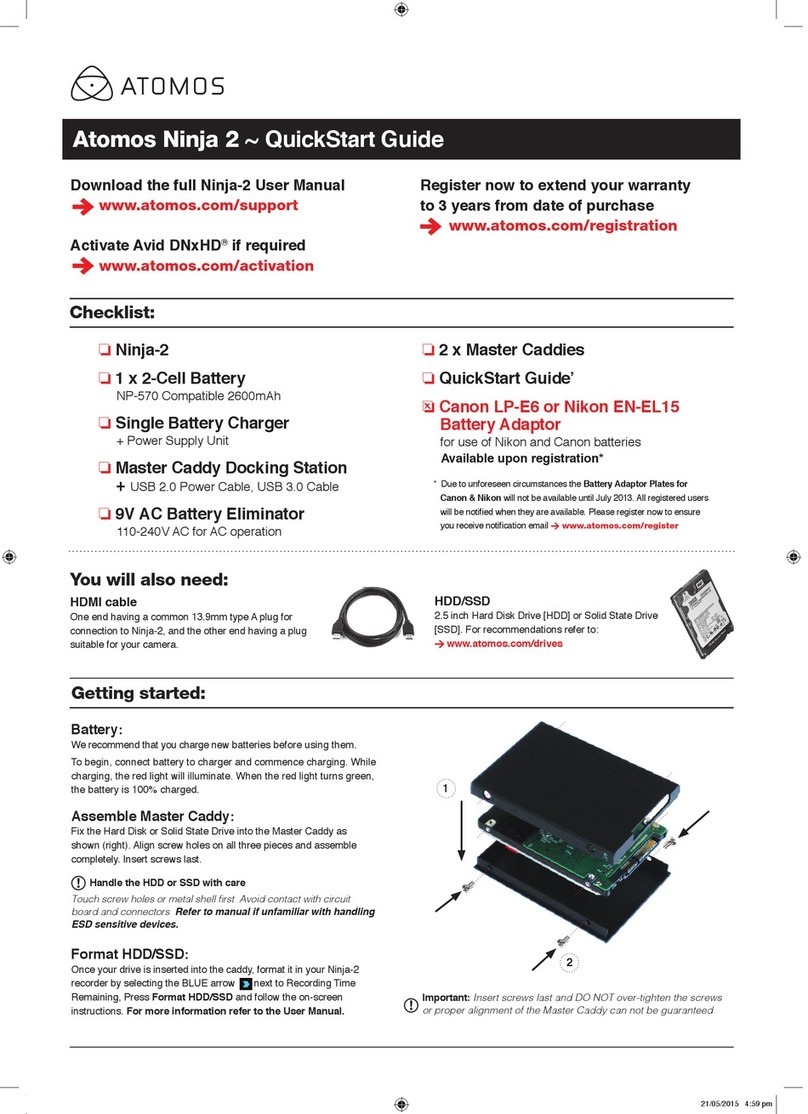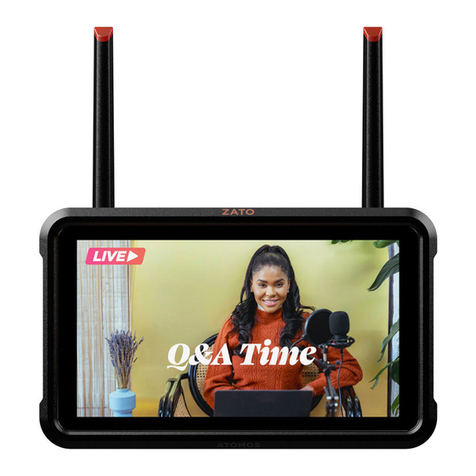*Subject to change without notice Atomos Shogun – User Manual Edition 1: December 2014 3
Notice
Copyright © 2014 ATOMOS Global Pty Ltd (‘referred to as ATOMOS’).
All rights reserved. All information in this document is subject to change
without notice. No part of the document may be reproduced or transmitted
in any form, or by any means, electronic or mechanical, including
photocopying or recording, without the express written permission
of ATOMOS. A reference to ATOMOS includes its related entities,
subsidiaries and parent company.
Trademarks
Shogun and ATOMOS are registered trademarks of ATOMOS.
Apple, the Apple logo, AppleShare, AppleTalk, FireWire, iPod, iPod
Touch, Mac, and Macintosh are registered trademarks of Apple Inc. Final
Cut Pro, QuickTime and the QuickTime Logo are trademarks of Apple
Inc. All other trademarks are the property of their respective holders.
International Hardware Limited Warranty
ATOMOS warrants that:
• the main product, not including TFT/LCD, or any external accessories,
will be free from defects in materials and workmanship for a period of
1 years from the date of purchase, the user may upgrade to a 3 year
warranty upon registering their product at www.atomos.com
• the TFT/LCD, batteries, battery charger, HDD/SSD docking station,
Master Caddy and Carry Case will be free from defects in materials
and workmanship for a period of 1 year from the date of purchase.
Thiswarrantyisexclusivelyforthebenetoftheoriginalpurchaserandis
not assignable or transferable.
If during the warranty period the product is shown to be defective
ATOMOS may at its option:
a) replace the goods or supply equivalent ones, b) repair the goods,
c) pay the cost of replacing the goods or of acquiring equivalent ones and
d) paying the cost of having the goods repaired;
The customer must notify ATOMOS of any defect in the goods in writing
prior to the expiry of the warranty periods set out above. The customer
will be solely responsible for returning the goods to ATOMOS or its
authorizeddistributor.UponacceptanceofawarrantyclaimbyATOMOS,
where ATOMOS repairs or replaces the goods, it will be responsible for
reasonable shipping costs incurred in sending the goods to the Customer,
provided that customer is located in a country in which ATOMOS has an
authorizeddistributororrepaircentreoragent.
Warranty Exclusions
This warranty applies only to defects in workmanship and does not cover
defects caused by:
• Neglect;
• Improper or negligent acts or omissions;
• Unauthorised repairs or attempted repairs;
•Tamperingwithormodicationofthegoods;
• Connection to incompatible equipment or power sources;
• Exposure to water or weather;
•Exposuretomagneticeldsorcorrosiveliquidsorsubstances;
• Physical damage
EXCEPT AS STATED IN THIS WARRANTY, ATOMOS, IT’S VENDORS,
AGENTS, RESELLERS AND DISTRIBUTORS DISCLAIM IN THEIR ENTIRETY
ALL OTHER WARRANTIES, EXPRESS OR IMPLIED, INCLUDING WITHOUT
LIMITATION ALL WARRANTIES OF MERCHANTABILITY OR FITNESS FOR
A PARTICULAR PURPOSE. THE REMEDIES OUTLINED IN THIS WARRANTY
ARE THE EXCLUSIVE REMEDY A CUSTOMER HAS ARISING FROM
DEFECTIVE GOODS WHICH ARE SUBJECT TO THE WARRANTY.
ATOMOS DOES NOT WARRANT THAT THE GOODS WILL OPERATE IN A
MANNER WHICH IS ERROR FREE, OR UNINTERRUPTED. THE GOODS ARE
NOT INTENDED TO BE THE PRIMARY OR ONLY DATA STORAGE DEVICE
FOR DATA – CUSTOMERS ARE SOLELY RESPONSIBLE FOR BACK UP AND
PROTECTION OF DATA.
SoftwareLicenseAgreement
IMPORTANT, PLEASE READ CAREFULLY. THIS IS A LICENSE
AGREEMENT.
This ATOMOS software, related documentation, any included sample
imagesandotherles(the“Software”),isprotectedbycopyrightlawsand
international copyright treaties, as well as other intellectual property laws
and treaties. The Software is licensed, not sold.
ThisEndUserLicenseAgreement(“EULA”)isalegalagreementbetween
you (either an individual or a single entity) and ATOMOS with regard to
the copyrighted Software provided with this EULA. Use of the Software
provided to you by ATOMOS in whatever form or media, will constitute your
acceptance of these terms, unless separate terms are provided
by the software supplier, in which case certain additional or different
terms may apply. If you do not agree with the terms of this EULA, do not
download, install copy or use the Software. By installing, copying or
otherwise using the Software, you agree to be bound to the terms of this
EULA. If you do not agree to the terms of this EULA, ATOMOS is unwilling
to license the Software to you.
1.Eligible licensees. This Software is available for license solely to
purchasers of the ATOMOS Shogun, who have purchased a unit
manufactured by ATOMOS Shogun and purchased through an ATOMOS
authorizedreseller,withnorightofduplicationorfurtherdistribution,
licensing or sub-licensing.
2.License Grant. ATOMOS grants you a personal, non-transferable and
non-exclusive right to use the copy of the Software provided with this
EULA. You agree you will not copy the Software except as necessary
to use it with the ATOMOS Shogun. You agree that you may not copy
the written materials accompanying the Software. Modifying, reverse
engineering, translating, renting, copying, transferring or assigning
all or part of the Software or any rights granted hereunder, to any
other persons or reverse engineering the hardware on which the
Software runs, is strictly prohibited. The software is license, not sold.
You acknowledge that no title to intellectual property in the Software
is transferable to you. You further acknowledge that title and full
ownership rights to the Software will remain the exclusive property of
ATOMOS and/or its suppliers, and you will not acquire any rights to the
Software, except as expressly set forth above. All copies of the software
will contain the same proprietary notices as contained in or on the
Software. All title and copyrights in and to the Software (including but
not limited to any images, animations, video, audio, text incorporated),
the accompanying printed materials, and any copies of the Software are
owned by ATOMOS or its suppliers.
3.Reverse engineering. You agree that you will not attempt, and if you are
a corporation, you will use your best efforts to prevent your employees
and contractors from attempting to reverse compile, derive circuits,
modify, translate or disassemble the Software and/or the Atomos
Shogun in whole or in part. Any failure to comply with the above or any
other terms and conditions contained herein will result in the automatic
termination of this license and the reversion of the rights granted
hereunder by ATOMOS.
ATOMOS reserves the right to terminate this license without prejudice to
any additional recourse ATOMOS may have against you if you violate any
of its terms and conditions.
Warranty & Conditions
Registration + Warranty Upgrade
Standard warranty is 1 year. Register to upgrade your warranty to
3 years. Visit: www.atomos.com/registration
































